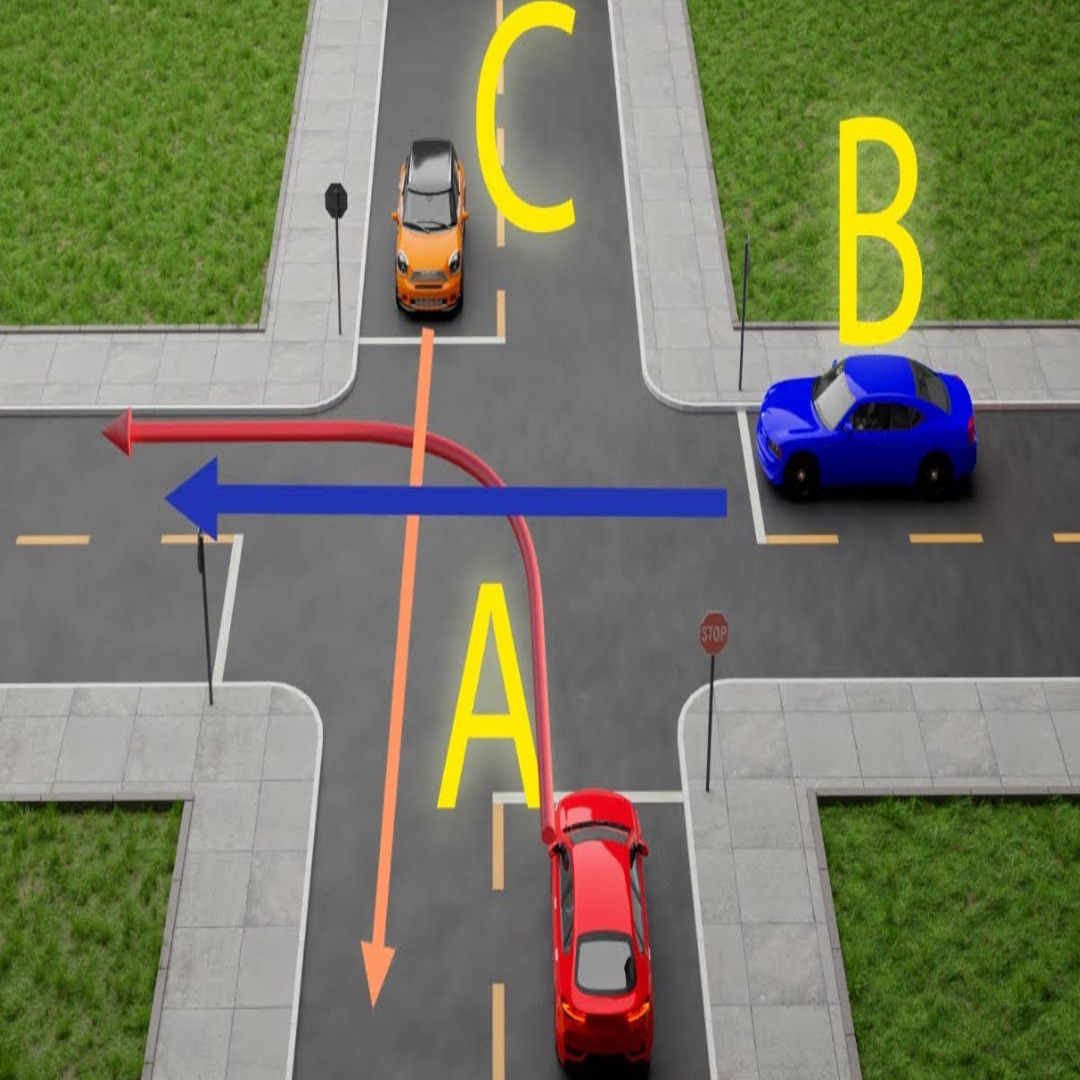Understanding right-of-way rules at intersections is essential for road safety and efficient traffic flow. Every day, drivers encounter situations where multiple vehicles reach an intersection at the same time, leading to confusion about who has the right of way. The scenario presented here involves three vehicles approaching an intersection from different directions, each with its own intended movement. The question is: which car has the right of way? The correct answer is Car C. Let’s analyze why.

Breaking Down the Intersection Scenario
In the image, three cars—A (red car), B (blue car), and C (orange car)—approach an intersection from different directions. Each driver plans to take a distinct route, creating a situation where understanding right-of-way rules is crucial. Here’s a closer look at each vehicle’s movement:
Car A (Red Car): Car A is at a stop sign and intends to make a left turn across oncoming traffic. Car B (Blue Car): Car B is also at a stop sign, approaching from a minor road, and plans to turn right. Car C (Orange Car): Car C is driving straight through the intersection on a main road without any stop sign.
Right-of-Way Rules at Intersections
Intersections are regulated by specific traffic rules that determine vehicle priority. In this case, the right-of-way principles that apply include:
Traffic Control Signs: Since Cars A and B both have stop signs, they must yield to any vehicles traveling on the main road. Car C, which does not have a stop sign, holds the right of way. Straight vs. Turning Traffic: Vehicles traveling straight generally have priority over those making turns, unless otherwise directed by traffic control devices. Since Car C is moving straight, it takes precedence over Cars A and B. Right Turns vs. Left Turns: If two vehicles arrive at an intersection, a vehicle making a right turn (Car B) has priority over a vehicle making a left turn (Car A) since the left-turning car must cross traffic.
Analyzing the Vehicles’ Movements
Car C (Orange Car): Since Car C is traveling straight on the main road and does not face a stop sign, it holds the right of way and can proceed without stopping. Car B (Blue Car): Car B, despite planning to turn right, must yield to Car C because it has a stop sign and is entering the main road. Car A (Red Car): Car A must yield to both Cars C and B. It faces a stop sign, is turning left across traffic, and must wait until both Car C and Car B have cleared the intersection before proceeding.
Why Car C Has the Right of Way
Car C has the right of way in this scenario for the following reasons:
It is traveling on the main road without any stop signs restricting its movement. Vehicles approaching from minor roads with stop signs must yield to those on the main road. Since Car C is moving straight and not turning, its path is the least obstructive and therefore takes priority.
Common Mistakes Drivers Make at Intersections
Misinterpreting right-of-way rules can lead to dangerous situations. Some common errors include:
Assuming Equal Priority: Many drivers mistakenly believe that all vehicles arriving at an intersection simultaneously share equal priority. However, right-of-way rules dictate otherwise. Rushing Through Intersections: Being too aggressive or too hesitant can disrupt traffic flow. It is important to follow the rules and proceed with caution. Ignoring Stop Signs: Some drivers fail to come to a full stop at stop signs, increasing the risk of collisions with vehicles that have the right of way.
The Importance of Yielding
Yielding when required is crucial for maintaining traffic safety and preventing unnecessary accidents. Here’s why yielding matters:
Prevents Accidents: Adhering to right-of-way rules significantly reduces the likelihood of collisions. Enhances Traffic Flow: Yielding appropriately ensures an orderly movement of vehicles, reducing congestion and confusion. Ensures Legal Compliance: Failure to yield can lead to legal consequences, including fines and liability in the event of an accident.
Safe Driving Tips for Intersections
To stay safe and avoid confusion at intersections, consider these best practices:
Observe Traffic Signs: Pay close attention to stop signs, yield signs, and traffic signals to determine your right of way. Anticipate Other Drivers’ Actions: Always be alert and ready for unexpected moves by other drivers. Communicate Clearly: Use turn signals and drive predictably to indicate your intentions to other drivers. Exercise Patience: Never rush through an intersection. Wait your turn and ensure the path is clear before proceeding.
Conclusion: Why Car C Takes Priority
In this scenario, Car C has the right of way because it is traveling straight on the main road without any stop signs. Cars A and B must yield since they face stop signs, and Car A must also yield to Car B due to its left-turn maneuver.
Understanding and respecting right-of-way rules are essential for maintaining road safety and traffic efficiency. The next time you approach an intersection like this, take a moment to assess the situation, follow the rules, and yield when necessary. Safe driving starts with informed decision-making and adherence to traffic laws





